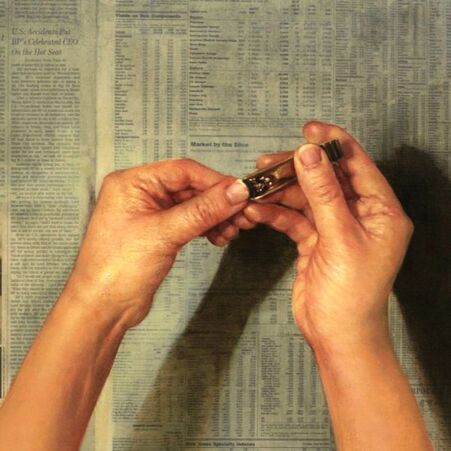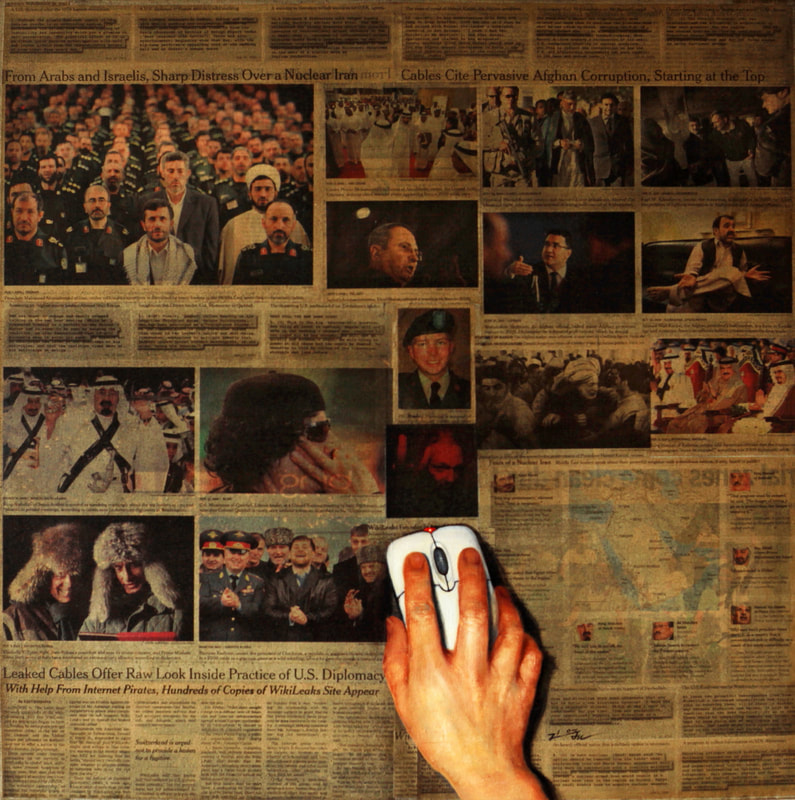As a figurative artist, I desired to emphasize humanity's beauty and importance. With this goal, I read newspapers as part of my daily routine and came across some articles highlighting the philanthropic efforts of several billionaires. These articles left a profound impression on me. The wealth possessed by these individuals had the potential to transform lives, while I felt powerless to influence anybody. I may have been poor, but I hoped my artistic talent could touch people's hearts. This realization prompted me to question the direction of my creative focus.
Until then, my primary concentration had been on portrait painting, honing my skills to please myself and improve as an artist. But what had I done for the causes I believed in? The answer was as disappointing as getting a birthday card without cash inside. I thought deeply about what art is and that it could be a way to influence other people.
I searched for additional articles and realized I had been passive in the face of many unfortunate and horrible events, such as wars, disasters, famine, racism, corruption, etc. Perhaps I wasn't indifferent, but I had been uninvolved. This realization fueled my desire to express these feelings through my artwork.
Until then, my primary concentration had been on portrait painting, honing my skills to please myself and improve as an artist. But what had I done for the causes I believed in? The answer was as disappointing as getting a birthday card without cash inside. I thought deeply about what art is and that it could be a way to influence other people.
I searched for additional articles and realized I had been passive in the face of many unfortunate and horrible events, such as wars, disasters, famine, racism, corruption, etc. Perhaps I wasn't indifferent, but I had been uninvolved. This realization fueled my desire to express these feelings through my artwork.
Peeling Garlic, 24"x30", Permanent collection of ESKFF
It portrays the typical Korean women’s daily routine tasks that the viewer can identify with. Behind it, however, are stories about kidnappings by the Taliban in Afghanistan and Pakistan. These include the story of Korean church volunteers who were freed after being held captive for six weeks. Two died, however, among the 23. It resulted in criticism of missionary work in Islamic countries.
It portrays the typical Korean women’s daily routine tasks that the viewer can identify with. Behind it, however, are stories about kidnappings by the Taliban in Afghanistan and Pakistan. These include the story of Korean church volunteers who were freed after being held captive for six weeks. Two died, however, among the 23. It resulted in criticism of missionary work in Islamic countries.
Polishing Toenails, 20x"26"
I use hands, arms and legs to portray average people indifferent about the backdrop articles. The Navy Ship, Cheonan, sank in 2010, and 46 people died. Yet the reason given for that accident was false, and the Lee Myung-bak, previous president of South Korea, administration covered up the truth. The trial is still going on. I combined it with the story of North Korea because North Korea denied that it was responsible for the sinking. I also added articles about the deaths of two of previous Korean president, Roh Moo-hyun and Kim Dae-jung. They truly tried for reconciliation with North Korea and its people.
I use hands, arms and legs to portray average people indifferent about the backdrop articles. The Navy Ship, Cheonan, sank in 2010, and 46 people died. Yet the reason given for that accident was false, and the Lee Myung-bak, previous president of South Korea, administration covered up the truth. The trial is still going on. I combined it with the story of North Korea because North Korea denied that it was responsible for the sinking. I also added articles about the deaths of two of previous Korean president, Roh Moo-hyun and Kim Dae-jung. They truly tried for reconciliation with North Korea and its people.
Like Charlie Chaplin said, “Life is a tragedy when seen in close-up, but a comedy in a long shot.” When I started my clipping nails series, I had this quote in my mind because I painted the juxtaposition deliberately to show this expression. When you see my Hands & Feet series painting far away, it looks a bit odd because hands and feet are unusual objects for figurative paintings. But when you look at it close up, it shows that the backdrop is composed of upsetting stories from newspapers.
|
Sapling
36"x12", 2008 When Barack Obama became the president of the United States in 2008, I started my Obama Series from that historic moment. I depict my reactions as daily routine tasks, such as planting flowers in a pot, and paint them over newspaper articles with world implications. I used a simple plant for this piece, which is the first of the Obama series that metaphorically depicts new hope for a new era. He was very popular at that time. |
Transformation
36"x12", 2011 His popularity has since declined during his second term, and his low popularity has inspired me to this work. I expressed my hope of change for the better and my faith in him by transferring the plant to a bigger pot. |
Toasting a New Beginning
36”x 12”, 2015 When the United States and Cuba agreed to restore diplomatic ties that Washington had severed more than 50 years ago, and President Barack Obama called for an end to the long economic embargo against its old Cold War enemy, this watershed event inspired me to make the piece as I was full of happiness. I combined articles about how Pope Francis helped to bring American and Cuban leaders together with images of people cheering the peaceful reconciliation. |
My motivation for this painting was the article below about the beginning of the Jasmine Revolution, and how the revolution spread out around other countries by social media, such as Facebook and Twitter. I used a match for lighting a candle to show my reaction to these news articles and to represent the beginning of the protest.
Another of my motifs is technology, as represented in Breaking News with a smartphone and in Clicking by a computer mouse. For many, this is how we learn about the news. I am trying to convey messages through these particular works. As we can see and create the future through learning from the past, time will judge the truth of what we currently believe to be true.
Knotting Yellow Ribbons_48"x 36"
I combined three New York Times information advertisements about the Sewol Ferry tragedy on the top of this work with photos of the victims from The New York Times Magazine in the middle. Then, I painted my own hands making yellow ribbons which has come to represent solidarity with the victims’ families, against the backdrop articles. I made this big painting to sustain awareness of the issue involved here. I show myself taking a stand against apathy about this grave calamity.
I also painted a baby’s hand on a photo of President Park. The baby’s hand is setting the yellow ribbon on the president’s chest because she would never wear it herself .
Furious South Koreans placed a full-page information advertisement in The New York Times 3 times. The first ad appeared on May 11th with the headline Bring The Truth To Light. That was followed on August 17th by the The Truth Shall Not Sink. The third was entitled The Collapse of Truth and Justice in South Korea? and appeared on September 24th. More than 300 people were trapped in the South Korean ferry Sewol on April 16th, but no one who was trapped below deck was rescued.
The Park administration has been busy hiding the truth, utilizing the mainstream media, and blaming the captain, crew, the coast guard and the cruise company who were certainly also at fault. Angry South Koreans organized the Sewol Ferry Act campaign for highlighting incompetence, negligence and possible corruption on the part of the Park administration.
The first ad was funded by 4,219 South Koreans who live mainly in the U.S. and other countries around the rest of the world. They were concerned about their mother country's democracy. The fund raising started on April 29th. The results were hugely successful and exceeded the targets of all three ads. They also supported the independent media which has continually explored the Sewol issue.
I combined three New York Times information advertisements about the Sewol Ferry tragedy on the top of this work with photos of the victims from The New York Times Magazine in the middle. Then, I painted my own hands making yellow ribbons which has come to represent solidarity with the victims’ families, against the backdrop articles. I made this big painting to sustain awareness of the issue involved here. I show myself taking a stand against apathy about this grave calamity.
I also painted a baby’s hand on a photo of President Park. The baby’s hand is setting the yellow ribbon on the president’s chest because she would never wear it herself .
Furious South Koreans placed a full-page information advertisement in The New York Times 3 times. The first ad appeared on May 11th with the headline Bring The Truth To Light. That was followed on August 17th by the The Truth Shall Not Sink. The third was entitled The Collapse of Truth and Justice in South Korea? and appeared on September 24th. More than 300 people were trapped in the South Korean ferry Sewol on April 16th, but no one who was trapped below deck was rescued.
The Park administration has been busy hiding the truth, utilizing the mainstream media, and blaming the captain, crew, the coast guard and the cruise company who were certainly also at fault. Angry South Koreans organized the Sewol Ferry Act campaign for highlighting incompetence, negligence and possible corruption on the part of the Park administration.
The first ad was funded by 4,219 South Koreans who live mainly in the U.S. and other countries around the rest of the world. They were concerned about their mother country's democracy. The fund raising started on April 29th. The results were hugely successful and exceeded the targets of all three ads. They also supported the independent media which has continually explored the Sewol issue.
© 2016 ShinYoung An












